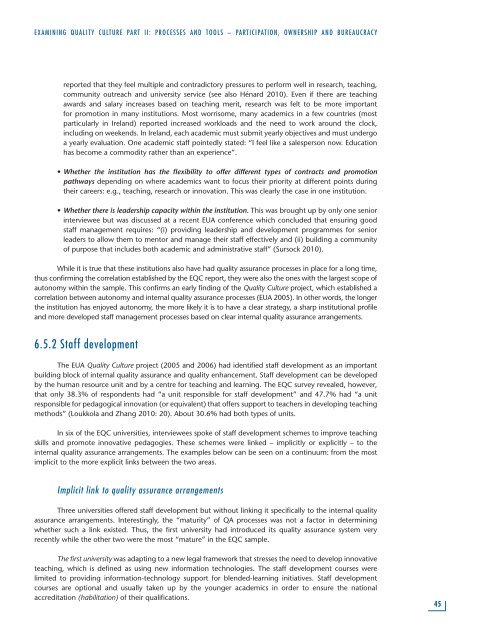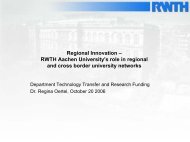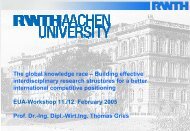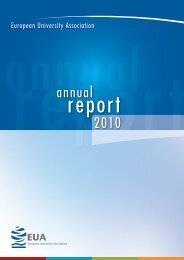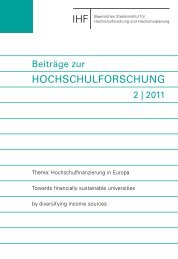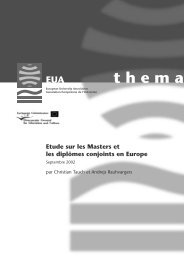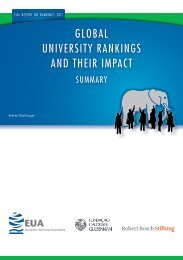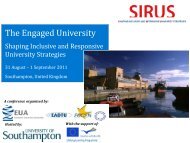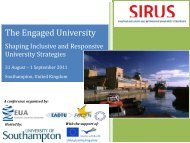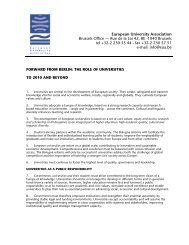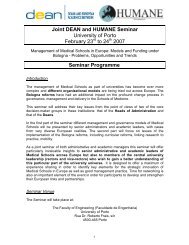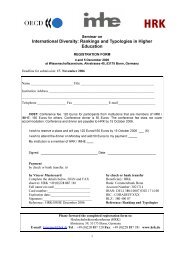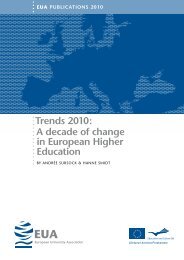Examining Quality Culture Part II: - European University Association
Examining Quality Culture Part II: - European University Association
Examining Quality Culture Part II: - European University Association
You also want an ePaper? Increase the reach of your titles
YUMPU automatically turns print PDFs into web optimized ePapers that Google loves.
ExAmININg QUALITy CULTUrE PArT <strong>II</strong>: PrOCESSES ANd TOOLS – PArTICIPATION, OwNErShIP ANd BUrEAUCrACy<br />
reported that they feel multiple and contradictory pressures to perform well in research, teaching,<br />
community outreach and university service (see also Hénard 2010). Even if there are teaching<br />
awards and salary increases based on teaching merit, research was felt to be more important<br />
for promotion in many institutions. Most worrisome, many academics in a few countries (most<br />
particularly in Ireland) reported increased workloads and the need to work around the clock,<br />
including on weekends. In Ireland, each academic must submit yearly objectives and must undergo<br />
a yearly evaluation. One academic staff pointedly stated: “I feel like a salesperson now. Education<br />
has become a commodity rather than an experience”.<br />
• Whether the institution has the flexibility to offer different types of contracts and promotion<br />
pathways depending on where academics want to focus their priority at different points during<br />
their careers: e.g., teaching, research or innovation. This was clearly the case in one institution.<br />
• Whether there is leadership capacity within the institution. This was brought up by only one senior<br />
interviewee but was discussed at a recent EUA conference which concluded that ensuring good<br />
staff management requires: “(i) providing leadership and development programmes for senior<br />
leaders to allow them to mentor and manage their staff effectively and (ii) building a community<br />
of purpose that includes both academic and administrative staff” (Sursock 2010).<br />
While it is true that these institutions also have had quality assurance processes in place for a long time,<br />
thus confirming the correlation established by the EQC report, they were also the ones with the largest scope of<br />
autonomy within the sample. This confirms an early finding of the <strong>Quality</strong> <strong>Culture</strong> project, which established a<br />
correlation between autonomy and internal quality assurance processes (EUA 2005). In other words, the longer<br />
the institution has enjoyed autonomy, the more likely it is to have a clear strategy, a sharp institutional profile<br />
and more developed staff management processes based on clear internal quality assurance arrangements.<br />
6.5.2 Staff development<br />
The EUA <strong>Quality</strong> <strong>Culture</strong> project (2005 and 2006) had identified staff development as an important<br />
building block of internal quality assurance and quality enhancement. Staff development can be developed<br />
by the human resource unit and by a centre for teaching and learning. The EQC survey revealed, however,<br />
that only 38.3% of respondents had “a unit responsible for staff development” and 47.7% had “a unit<br />
responsible for pedagogical innovation (or equivalent) that offers support to teachers in developing teaching<br />
methods” (Loukkola and Zhang 2010: 20). About 30.6% had both types of units.<br />
In six of the EQC universities, interviewees spoke of staff development schemes to improve teaching<br />
skills and promote innovative pedagogies. These schemes were linked – implicitly or explicitly – to the<br />
internal quality assurance arrangements. The examples below can be seen on a continuum: from the most<br />
implicit to the more explicit links between the two areas.<br />
Implicit link to quality assurance arrangements<br />
Three universities offered staff development but without linking it specifically to the internal quality<br />
assurance arrangements. Interestingly, the “maturity” of QA processes was not a factor in determining<br />
whether such a link existed. Thus, the first university had introduced its quality assurance system very<br />
recently while the other two were the most “mature” in the EQC sample.<br />
The first university was adapting to a new legal framework that stresses the need to develop innovative<br />
teaching, which is defined as using new information technologies. The staff development courses were<br />
limited to providing information-technology support for blended-learning initiatives. Staff development<br />
courses are optional and usually taken up by the younger academics in order to ensure the national<br />
accreditation (habilitation) of their qualifications.<br />
45


